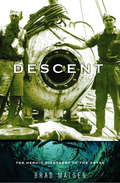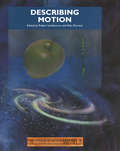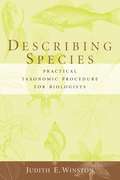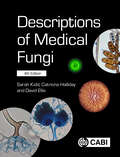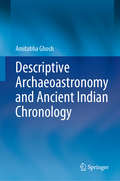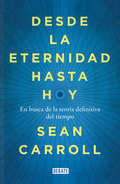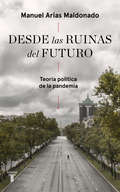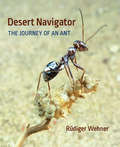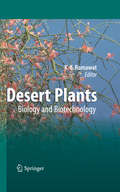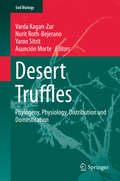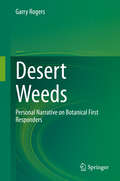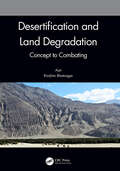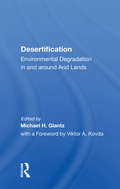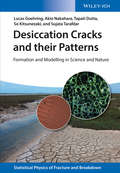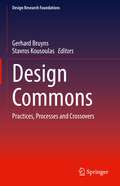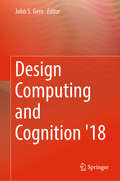- Table View
- List View
Descartes-Agonistes
by John SchusterThis book reconstructs key aspects of the early career of Descartes from 1618 to 1633; that is, up through the point of his composing his first system of natural philosophy, Le Monde, in 1629-33. It focuses upon the overlapping and intertwined development of Descartes' projects in physico-mathematics, analytical mathematics, universal method, and, finally, systematic corpuscular-mechanical natural philosophy. The concern is not simply with the conceptual and technical aspects of these projects; but, with Descartes' agendas within them and his construction and presentation of his intellectual identity in relation to them. Descartes' technical projects, agendas and senses of identity shifted over time, entangled and displayed great successes and deep failures, as he morphed from a mathematically competent, Jesuit trained graduate in neo-Scholastic Aristotelianism to aspiring prophet of a systematised corpuscular-mechanism, passing through stages of being a committed physico-mathematicus, advocate of a putative 'universal mathematics', and projector of a grand methodological dream. In all three dimensions--projects, agendas and identity concerns--the young Descartes struggled and contended, with himself and with real or virtual peers and competitors, hence the title 'Descartes-Agonistes'.
Descent: The Heroic Discovery of the Abyss
by Bradford MatsenBrad Matsen brings to vivid life the famous deep-sea expeditions of Otis Barton and William Beebe. Beebe was a very well-connected and internationally acclaimed naturalist, with the power to generate media attention. Barton was an engineer and heir to a considerable fortune, who had long dreamed of making his mark on the world as an adventurer. Together, Beebe and Barton would achieve what no one had done before--direct observation of life in the blackness of the abyss. Here, against the back drop of the depression, is their riveting tale.
Describing Motion: The Physical World
by Robert LambourneDescribing Motion: The Physical World provides the quantitative description of a variety of physically important motions. Starting with simple examples of motion along a line, the book introduces key concepts, such as position, velocity, and acceleration, using the fundamental rules of differential calculus. Topics include the free-fall motion of m
Describing Species: Practical Taxonomic Procedure for Biologists
by Judith WinstonA basic practical manual for the process of describing new species, this desperately needed desk reference and guide to nomenclatural procedure and taxonomic writing serves as a Strunk & White of species description, covering both botanical and zoological codes of nomenclature.
Describing Species: Practical Taxonomic Procedure for Biologists
by Judith WinstonNew species are discovered every day—and cataloguing all of them has grown into a nearly insurmountable task worldwide. Now, this definitive reference manual acts as a style guide for writing and filing species descriptions. New collecting techniques and new technology have led to a dramatic increase in the number of species that are discovered. Explorations of unstudied regions and new habitats for almost any group of organisms can result in a large number of new species discoveries—and hence the need to be described. Yet there is no one source a student or researcher can readily consult to learn the basic practical aspects of taxonomic procedures.Species description can present a variety of difficulties: Problems arise when new species are not given names because their discoverers do not know how to write a formal species description or when these species are poorly described. Biologists may also have to deal with nomenclatural problems created by previous workers or resulting from new information generated by their own research. This practical resource for scientists and students contains instructions and examples showing how to describe newly discovered species in both the animal and plant kingdoms.With special chapters on publishing taxonomic papers and on ecology in species description, as well as sections covering subspecies, genus-level, and higher taxa descriptions, Describing Species enhances any writer's taxonomic projects, reports, checklists, floras, faunal surveys, revisions, monographs, or guides.The volume is based on current versions of the International Codes of Zoological and Botanical Nomenclature and recognizes that systematics is a global and multicultural exercise. Though Describing Species has been written for an English-speaking audience, it is useful anywhere Taxonomy is spoken and will be a valuable tool for professionals and students in zoology, botany, ecology, paleontology, and other fields of biology.
Descriptions of Medical Fungi
by Dr Sarah Kidd Dr Catriona Halliday Professor David EllisThe 4th edition of this book provides laboratory staff and clinicians with a quick benchtop reference on the identification and antifungal susceptibility of human and animal fungal infections. It contains descriptions of all the major medical fungal pathogens, 179 species from 109 genera. This updated edition includes new and revised descriptions and he authors have reconciled current morphological descriptions and name changes with more recent genetic data. The most common fungal species are described, including members of the yeasts, mucoromycetes, conidial moulds, dimorphic pathogens, and dermatophytes. The book features: updates to taxonomy and fungal names. more than 350 colour photographs. antifungal susceptibility profiles, including for new drugs where available. methods of identification including molecular and/or MALDI-ToF mass spectroscopy. This handy reference is essential for laboratory staff and clinicians dealing with the identification and management of human and animal fungal infections, researchers in medical microbiology and mycology laboratories.
Descriptive Archaeoastronomy and Ancient Indian Chronology
by Amitabha GhoshThis book presents the basic fundamentals of descriptive archaeoastronomy and its application to the astronomical descriptions found in ancient Indian scriptures. Archaeoastronomy is a branch of positional astronomy that helps to determine the epochs of ancient astronomical alignments and special astronomical events. In this book, only the descriptions of special stellar alignments and events found in ancient texts can identify the antiquity of the descriptions. India possesses a large volume of ancient scriptures like Vedas and Puranas which contain many astronomical descriptions as in ancient India positional astronomy was well developed. The antiquities of these texts are determined through archaeoastronomical techniques. Major events like Mahabharata War are dated and using these dates a chronology of ancient India is determined. The astronomically determined chronology is compared with the results from various archaeological, palaeoclimatological, geological and genealogical investigations of ancient India. This introductory book interests readers interested in unveiling the mystery involved with the protohistory of this ancient civilization.
Descriptive Inorganic, Coordination, and Solid State Chemistry
by Glen E. RodgersThis proven book introduces the basics of coordination, solid-state, and descriptive main-group chemistry in a uniquely accessible manner, featuring a "less is more" approach. Consistent with the "less is more" philosophy, the book does not review topics covered in general chemistry, but rather moves directly into topics central to inorganic chemistry. Written in a conversational prose style that is enjoyable and easy to understand, this book presents not only the basic theories and methods of inorganic chemistry (in three self-standing sections), but also a great deal of the history and applications of the discipline. This edition features new art, more diversified applications, and a new icon system. And to better help readers understand how the seemingly disparate topics of the periodical table connect, the book offers revised coverage of the author's "Network of Interconnected Ideas" on new full color endpapers, as well as on a convenient tear-out card.
Descriptive Taxonomy
by Mark F. Watson Chris H. C. Lyal Colin A. Pendry Mark F. Watson Chris H. C. LyalIn an age when biodiversity is being lost at an unprecedented rate, it is vital that floristic and faunistic information is up to date, reliable and easily accessible for the formulation of effective conservation strategies. Electronic data management and communication are transforming descriptive taxonomy radically, enhancing both the collection and dissemination of crucial data on biodiversity. This volume is written by scientists at the forefront of current developments of floras and faunas, along with specialists from applied user groups. The chapters review novel methods of research, development and dissemination, which aim to maximise the relevance and impact of data. Regional case studies are used to illustrate the outputs and impacts of taxonomic research. Integrated approaches are presented which have the capacity to accelerate the production of floras and faunas and to better serve the needs of a widening audience.
Desde la eternidad hasta hoy: En busca de la teoría definitiva del tiempo
by Sean CarrollA partir de la entropía, la física cuántica, los viajes en el tiempo o el significado de la vida, Sean Carroll profundiza en uno de los grandes enigmas de la ciencia: ¿Qué es el tiempo? Hace veinte años Stephen Hawking intentó explicar el tiempo a través de la comprensión del big bang. Ahora, en Desde la eternidad hasta hoy, Sean Carroll, uno de los mejores físicos teóricos del mundo, nos ofrece una teoría revolucionaria que ilustra cómo la flecha del tiempo existe gracias a condiciones previas al big bang, una era con la que Einstein ni siquiera soñó, y que explica que nuestro universo convive con universos paralelos en los que el tiempo viaja en dirección opuesta. Autoridades en el campo de la física teórica opinan... «Una exploración cautivadora de los misterios del tiempo.» Brian Green «Lúcido y profundo.» Kip S. Thome Y la prensa afirma... «Desde la eternidad hasta hoy es una de las mejores explicaciones de los misterios asombrosos de nuestro universo.» The Wall Street Journal «Carroll utiliza un lenguaje coloquial y accesible para explorar los desafíos de la cosmología.» Library Journal
Desde las ruinas del futuro
by Manuel Arias MaldonadoSi queremos evitar futuros sobresaltos, es necesario explicar la crisis y elucidar sus significados. La pandemia de la COVID-19 ha sacudido a la humanidad con una fuerza inopinada: un virus de origen animal ha obligado a los ciudadanos de gran parte del globo a quedarse en casa, y el mundo acelerado de la globalización se ha detenido ante la mirada perpleja de los contemporáneos. Millones de personas han enfermado y cientos de miles han muerto, mientras el uso masivo de las mascarillas nos recordaba a diario que la habitabilidad del planeta no puede darse por supuesta. Así que, un siglo después de la Gripe Española, otro virus infeccioso ha actuado como agente histórico de primer orden. Y esta catástrofe inesperada, mas no imprevista, aguarda ahora a sus intérpretes. Manuel Arias Maldonado se aproxima a la pandemia como al fenómeno polisémico que es: efecto colateral de las relaciones socionaturales y riesgo global que a duraspenas encaja en las categorías dominantes; la acción del virus fuerza a las democracias a operar en condiciones excepcionales dominadas por la incertidumbre. Pero el virus también activa nuevos imaginarios colectivos y reabre el debate sobre un futuro que se presenta menos como promesa que como amenaza. Rehuyendo cualquier tentación profética, el autor defiende la capacidad del viejo pensamiento ilustrado para procesar con éxito este acontecimiento sublime, cuya causa no debe buscarse en el fracaso de la modernidad sino en su carácter asimétrico e inacabado. La crítica ha dicho sobre el autor:«Leer a Arias Maldonado siempre nos ayuda a entender cómo está cambiando el mundo.»Daniel Gascón, Letras Libres «Arias Maldonado no es un politólogo sino un filósofo político. La diferencia entre ambos oficios es la misma que separa al interiorista del arquitecto. Arias es un académico cuya kantiana ambición es toda la que quepa en la consideración científica de la política. Su trabajo trasciende el corral patrio para dialogar con homólogos extranjeros sobre desafíos estructurales de la democracia occidental.»Jorge Bustos, El Cultural
Desert Landscapes of the World with Google Earth
by Andrew GoudieThis book presents an introduction to desert landscapes—primarily landforms that are natural and man-made. It is based around the presentation of a series of beautiful and informative annotated Google Earth images. These are accompanied by text that describes the feature(s) concerned, their location, and their origin. There are also, in some cases, ground images taken by the author.
Desert Life
by Rachel MannA short book about life in the U.S. southwestern desert. Describes plants and animals, and people who live there. Photos are described.
Desert Navigator: The Journey of the Ant
by Rüdiger WehnerCataglyphis ants can set out across vast expanses of desert terrain in search of prey, and then find the shortest way home. Rüdiger Wehner has devised elegant experiments to unmask how they do it. Through a lively and lucid narrative, he offers a firsthand look at the extraordinary navigational skills of these charismatic creatures.
Desert Plants
by Kishan Gopal RamawatVast areas of Earth's landmass exist as deserts, representing quite distinct ecosystems. Desert plants and animals have evolved specialised survival strategies to cope with the harsh environment of high temperatures and scarce water resources. The life-supporting vegetation of deserts is characterised by its unique reproductive biology, metabolism and adaptive characters. Plants like Prosopis cineraria and date palm form the basis of the rural economy in many countries, and are of great cultural importance; Jojoba and Jatropha have attracted interest as non-conventional sources of industrial oil and biodiesel. This book includes chapters on the seed biology, reproduction, mycorrhizae, stress physiology, and metabolism of desert plants, and describes current biotechnological approaches to their cultivation. It will be useful to researchers, teachers and students in the fields of plant sciences, agriculture, and forestry, and those involved in the management and conservation of desert ecosystems.
Desert Truffles
by Varda Kagan-Zur Nurit Roth-Bejerano Yaron Sitrit Asunción MorteDesert truffles are found in every known desert, irrespective of the habitat - cool or hot, loamy or acidic, sandy or heavy soil - the only common condition seems to be a limited supply of water. In contrast to 'true' truffles, desert truffles have evolved over time in different families, mainly within the order Pezizales. While in some arid areas, desert truffles have been traditionally used as food, in most regions interest has only recently been increasing, and truffles are now treasured for their nutritional value, as an income source and for research. This volume gives a comprehensive overview of the phylogeny, biology, mycorrhizal association, and distribution of desert truffles, their use, biochemical and medicinal properties, as well as their domestication and cultivation.
Desert Weeds: Personal Narrative on Botanical First Responders
by Garry RogersIn their rapid colonization of soil exposed by fires, floods, and grazing animals, weeds resemble the human specialists we label Emergency Medical Technicians (EMTs). Weeds are the first responders when disasters occur in nature. They occupy bare soil and prevent erosion by wind and water. In extreme cases such as a landslide, weeds are essential to the healing processes that replace the lost soil. Like a Band-Aid on a skinned knee, weeds protect the land while it recovers. Besides protecting the soil after disaster, weeds provide food for wildlife, and some of them provide food and medicine for people. Able to withstand harsh conditions, weeds will proliferate as global warming and other human impacts intensify. Thus, nature’s EMTs will increase while all other plants decline. The book provides a succinct definition of weeds according to their form and function in ecosystem processes. The narrative uses a representative set of weed species from a desert location to illustrate the full range of weed characteristics.
Desertification and Land Degradation: Concept to Combating
by Ajai Rimjhim BhatnagarDesertification and land degradation are complex phenomena, and we need to understand their causes, consequences, and means to mitigate and combat their impact. Therefore, this book aims to explain the concept and characteristics of drylands, desert and desertification, land degradation, wastelands, and the concept of ecosystem services. It also discusses various types of processes of land degradations, their characteristics, physics and indicators along with mapping, monitoring and assessment of methods involved. Concept of Ocean Biological Deserts is discussed along with international and regional efforts towards combating land degradation and desertification. Key Features:• Provides all the aspect of desertification and land degradation at one place • Includes comprehensive methods to monitor different desertification/land degradation processes • Comprehensive overview of the mapping, monitoring and modelling techniques • Role of space borne data in identifying, monitoring and combating desertification is evaluated and reported with real case studies • Explains the concept of ocean biological deserts, their characteristics and mapping
Desertification: Environmental Degradation In And Around Arid Lands
by Michael H. GlantzThe United Nations Water Conference (in Argentina in March 1977) and the United Nations Conference to Combat Desertification (in Kenya in August 1977) reflect the worldwide attention that recent global food shortages and growing populations have drawn to the destruction of arable and potentially arable land. This collection of articles focuses on a primary form of such destruction: desertification—the creation of desert-like conditions in arid or semiarid regions either by changes in climate patterns or by human mismanagement, or both. The contributors—representing a range of disciplines—examine and evaluate the social, political, economic, environmental, and technical problems related to the causes and effects of desertification.
Deserts
by Donna LathamInvestigating the planet's biomes and examining the modern threats to each ecosystem, this interactive series challenges young readers to look at how their own actions influence the planet's health. With compare-and-contrast facts and vocabulary-building sidebars, each engaging guide reveals how environmental threats-both human and natural-affect plants and animals. Examining this growing biome, this guide shows that the desert is more than just a giant sandbox. Discussing desertification and how environmental change-such as ranching, overdevelopment, and cactus collection-in this area can threaten life outside the desert, this resource instructs students on the need to treat the desert with care.
Deserts: An Activity Guide for Ages 6–9
by Nancy CastaldoThis activity guide introduces children to the wild and often misunderstood environment of the desert and the people and cultures that thrive in and around them. Information is included on all types of deserts--hot and dry, coastal, semiarid, and polar. Kids learn what defines a desert and the creative ways plants and animals have adapted to survive in harsh desert environments. Also discussed are urban sprawl and its effects on desert habitats and how children can help protect this delicate environment by conserving energy and reducing consumption of petroleum-based products. Engaging activities include drawing a petroglyph, making a coral snake bracelet, frying prickly pears, conducting a gerbil study, and making sand art.
Desiccation Cracks and their Patterns: Formation and Modelling in Science and Nature
by Lucas Goehring Sujata Tarafdar Tapati Dutta So Kitsunezaki Akio NakaharaBringing together basic ideas, classical theories, recent experimental and theoretical aspects, this book explains desiccation cracks from simple, easily-comprehensible cases to more complex, applied situations. The ideal team of authors, combining experimental and theoretical backgrounds, and with experience in both physical and earth sciences, discuss how the study of cracks can lead to the design of crack-resistant materials, as well as how cracks can be grown to generate patterned surfaces at the nano- and micro-scales. Important research and recent developments on tailoring desiccation cracks by different methods are covered, supported by straightforward, yet deep theoretical models. Intended for a broad readership spanning physics, materials science, and engineering to the geosciences, the book also includes additional reading especially for students engaged in pattern formation research.
Design Acoustics: Primary and Secondary Noise Mitigation
by Gh. Reza SinambariThis technical book focuses on the acoustic analysis of weak points in a comprehensible manner. This reliably helps the designer and acoustician to understand the noise development of machines and systems and to develop suitable primary and secondary noise reduction measures. Selected application examples from practice support the user in developing his own ideas for the implementation of product-related noise reductions.
Design Commons: Practices, Processes and Crossovers (Design Research Foundations)
by Gerhard Bruyns Stavros KousoulasThis book directly links the notion of the commons with different design praxes, and explores their social, cultural, and ecological ramifications. It draws out material conditions in four areas of design interest: social design, commons and culture, ecology and transdisciplinary design. As a collection of positions, the diversity of arguments advances the understanding of the commons as both concepts and modes of thinking, and their material translation when contextualised in the domain of design questions. In other words, it moves abstract social science concepts towards concrete design debates. This text appeals to students, researchers and practitioners working on design in architecture, architecture theory, urbanism, and ecology.
Design Computing and Cognition ’18
by John S. GeroThis is the proceedings of the Eighth International Conference on Design Computing and Cognition (DCC’18) held at the Polytecnico di Milano in Italy. This volume presents both advances in theory and applications and demonstrates the depth and breadth of design computing and design cognition. Design thinking, the label given to the acts of designing, has become a paradigmatic view that has transcended the discipline of design and is now widely used in business and elsewhere. As a consequence there is an increasing interest in design research. This volume contains papers that represent the state-of-the-art research and developments in design computing and design cognition. This book is of particular interest to researchers, developers and users of advanced computation in design and those who need to gain a better understanding of designing that can be obtained through empirical studies.

